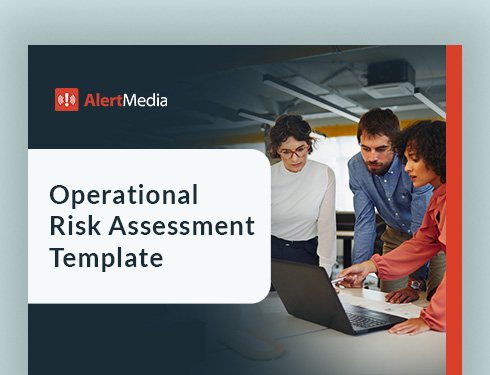
Economic Risk Examples and Preparedness Strategies for 2025
Economic risks are rising—including inflation, supply chain chaos, and global tensions. Stay ahead with smart strategies to protect your business in 2025.

As a business leader, you can’t control the economy, but you can prepare for economic risks. For example, the early 2025 LA wildfires caused an estimated $250 billion and $275 billion in damage. Beyond the devastating loss of homes and lives, disasters wreak havoc on supply chains, drive up costs, and test businesses’ crisis plans.
The rest of 2025 will likely bring more disruptions, from geopolitical conflicts and trade disputes to climate events and technology shifts. With economic uncertainty stretching into the next several years, business leaders must take proactive steps to manage risk and stay ahead of threats.
In this article, we’ll define economic risks, explore real-life examples, and provide actionable risk management and mitigation strategies to help businesses prepare for what may come.
Download Our Operational Risk Assessment Template
What Are Economic Risks?
Economic risks are market conditions that threaten a business’s stability, profitability, and long-term success. These risks often arise due to macroeconomic changes that can create financial and operational instability. The types of economic risk include:
- Geopolitical tensions
- Inflation
- Governmental instability
- Policy changes
- Natural disasters
- Interest rate changes
- Economic downturns
- Supply chain disruptions
For example, when inflation rises, businesses face higher costs for raw materials, labor, and logistics, which erode profit margins. Economic risks can vary in scope, affecting businesses locally, regionally, or globally, depending on their operational footprint.
The COVID-19 pandemic demonstrated how a global economic shock can disrupt supply chains, shut down industries, and alter consumer behavior worldwide. Meanwhile, the Russia-Ukraine war created regional instability that slowed business operations in affected areas and triggered ripple effects in energy and commodity markets worldwide.
Staying resilient in the face of unpredictable threats means businesses and security leaders need to anticipate weaknesses and plan ahead. Business continuity planning is pivotal in helping organizations prepare for potential risks and stay protected.
For example, companies may use hedging strategies during times of market volatility to offset financial exposure. In response to supply chain disruptions, they diversify suppliers or adopt real-time risk intelligence platforms to detect threats early.
Proactive risk management isn’t optional—it’s a necessity. To strengthen your business against economic uncertainty, start by conducting a risk assessment using our operational risk assessment template to identify vulnerabilities and create a structured response plan.
Real-World Economic Risk Examples
Businesses around the globe have faced economic risks that affect their operations. The past few years have provided many real-world examples—let’s look at some.
Global supply chain disruptions

When the COVID-19 pandemic forced factory shutdowns in China and Southeast Asia, the semiconductor industry suffered a severe supply chain crisis. Multiple factors were at play— first, U.S. trade restrictions with China, enacted in September 2020, limited Chinese microchip imports. As access to materials sank, the demand for computers, iPads, and other electronics surged due to remote work and schooling, making the situation worse. Cryptocurrency adoption also increased during this time, further driving demand for chips to power digital transactions.
Add to that severe weather, factory fires, and a neon gas shortage caused by the Russia-Ukraine conflict. Before the war, Ukraine was a major supplier of neon, a key material in chip production. With supply constrained, manufacturing delays extended further.
Microchips are integral to modern technology—smartphones, computers, cars, and even critical infrastructure like water systems and dams. Automakers like Ford and Toyota faced significant production delays, losing billions in revenue. Meanwhile, companies with flexible supplier networks could adapt by sourcing alternative components and relying on in-house software engineering expertise.
Businesses can better handle disruptions through supply chain resilience measures, including diversifying suppliers, nearshoring, real-time monitoring, and investing in predictive analytics. Threat intelligence platforms can also help alert you to global threats in real time so you can respond smoothly and resume operations more quickly.
Inflation and rising costs
As soon as the pandemic wound down, inflation picked up speed. Rising costs for raw materials and logistics strained budgets and cut into profits. McDonald’s, for one, reported a 14% increase in operating expenses over a single quarter.
Higher production costs have forced businesses to raise prices to stay profitable. Companies that failed to balance pricing risked losing market share and revenue. Many companies also used technology (like Amazon’s automated warehouse processes) to deliver faster services and lower labor costs.
Currency fluctuation
Currency fluctuation is a major source of economic risk for businesses, especially those engaged in international trade.
For instance, products manufactured in a country with rising currency value could become more expensive for foreign customers. This could reduce export sales and profits when companies convert their earnings. However, if the currency weakens, exports might become cheaper. While it might increase sales, it could also raise the cost of imports.
Post-Brexit, the GBP declined in value against the Euro and U.S. Dollar. This drop lowered product prices for international customers and raised the expense of imports. British car maker Jaguar Land Rover, for instance, buys nearly all its parts from the EU. After Brexit, those parts became more expensive due to the weaker GBP.
Geopolitical tensions
Conflicts involving specific regions, such as oil-producing areas or major agricultural suppliers, can shift the global risk landscape. For example, the war between Russia and Ukraine drove up wheat prices worldwide since both countries are major wheat exporters.
Over time, the commodity market has adapted, but Europe and other regions continue to experience economic effects from higher energy prices and stalled or slowed supply chains. And market prices for oil have shifted as countries in the Middle East and Russia have raised uncertainty in the sector.
5 Top Economic Risk Examples for 2025
Businesses of all sizes should watch for significant economic risks this year—these predictions stem from past trends and upcoming events that could shape the financial landscape in 2025.
1. Prolonged inflation and stagflation concerns
Although experts predict inflation may drop to 3.4% in 2025, it still poses business risks. Price hikes have slowed compared to previous years, but ongoing labor strikes and economic volatility are still at play.
It’s one thing to deal with inflation, but when you combine high prices with slow economic growth, you get “stagflation.” When this happens, consumers tighten their budgets, companies struggle with rising costs, and profitability takes a hit. If wages don’t keep up, consumer spending could drop, creating a vicious cycle that slows the economy.
To manage this volatility, improve your internal processes to waste less material while maintaining product and service quality. Also, consider making cost changes and using hedging strategies to protect customers from high prices while still making profits.
2. Climate change and economic disruptions
Climate change is a real threat that affects more than the environment. The January 2025 LA fire disaster didn’t just destroy properties—it also severely handicapped supply chains and snagged business operations. Incidents like this aren’t isolated. Extreme weather conditions are becoming more frequent and are risky for businesses.
Those that fail to adapt to sustainability measures will be particularly vulnerable if a natural disaster happens. To survive this, you must build resilient supply chains using sustainable methods.
3. Geopolitical instability and trade fragmentation
More than 70 countries held elections in 2024, with more high-stakes votes ahead in 2025. Amid growing political unrest, election results could have cascading economic impacts.
For one, Friedrich Merz’s election as German chancellor could reshape EU trade and monetary policies. As one of the EU’s largest economies, any shift in Germany’s stance on trade agreements or tariffs could ripple across global markets.
Meanwhile, South Korean President Han Duck-Soo’s impeachment in December 2024 raises concerns over policy continuity. If new leadership changes trade priorities, businesses operating in the region could face new tariffs or regulatory shifts.
And U.S. trade policy remains in flux as President Trump imposes new tariffs, which will increase costs for businesses reliant on international suppliers.
How do you manage this? Expand your supply options to handle policy changes. You can manage market disruptions better by expanding your supplier base into new markets and monitoring trade policy updates.
4. Technological disruption and cybersecurity threats
In 2025, businesses are in a race with fast-changing technology. AI and automation boost efficiency but also bring risks. As companies rush to adapt, industries may face market swings.
Cybersecurity threats should also be on your radar. Online data and financial operations have led to an increase in both the number and complexity of cyberattacks. As Sarah Pratley, Senior Vice President of Global Intelligence at AlertMedia, said in The Employee Safety Podcast, global cybercrime damages are predicted to reach a staggering $10.5 trillion.
Cyber threats are inevitable in 2025; a single incident could destroy your business operations if you’re not careful. To avoid this risk, invest in preventive technology and train your employees to identify and report cyber threats.
5. Debt crises and financial instability
Debt is a huge risk for businesses in 2025. Foreign and corporate debts are piling up, especially given higher interest rates. Governments and companies struggle to meet debt obligations, which could lead to crises.
Financial chaos in one region quickly spills into nearby areas. A debt crisis in any significant corporate market could trigger severe consequences for worldwide stock prices. It could also affect international supply networks and exchange rates. Essentially, it’s a domino effect that can impact your business operations.
Stress-test your financial statements regularly. Can your existing financial structure operate under an additional rise in interest rates? Establishing effective liquidity management strategies can help you avoid a financial crisis.
How Business Leaders Can Prepare for 2025 Economic Risks
In this episode of The Employee Safety Podcast, we talk about preparing for the 2025 risk landscape. You already know risks are part of doing business. The question is, how do you handle them? Here’s how you can mitigate economic risks in 2025.
Proactive risk assessment and scenario planning
As a business leader, regularly check for risks to identify weak points and create solutions based on possible scenarios. That’s operational risk assessment 101. Your business can withstand financial risks when you have plans to handle various scenarios ahead of time.
Risk mitigation ideas:
- Create action plans to manage emergencies, such as natural disasters.
- Consider questions like, If our current supply chains fail, how will we proceed?
Need some help? Check out this video, where we share how to conduct a risk assessment to protect your business from potential losses.
Build business resilience
Imagine relying on a single supplier—and then they run into financial trouble or delivery delays. This scenario is far from impossible. The best approach is to develop your supply chains to handle disruptions through risk management, crisis management, incident response planning, and business continuity measures. Businesses that adapt quickly after a crisis are those with contingency plans in place.
Risk mitigation ideas:
- If you do business internationally, regularly review your trade exposure and assess the potential impact of policy shifts.
- Use a business impact analysis (BIA) to quantify potential losses and identify contingency measures to minimize risk.
- To further build resilience, develop a robust business continuity plan that aligns with ISO 22301. This ensures your business can continue operating, even during a crisis. Your plan should address significant risks—including supply chain disruptions, inflation rates, or political instability—and outline clear steps to maintain operations during challenging times.
Financial preparedness
There are a number of steps you can take to increase financial preparedness.
Risk mitigation ideas:
- Set aside 3–6 months of operating expenses in a liquid, low-risk account (e.g., high-yield savings or money market account). This ensures liquidity during market downturns, supply chain disruptions, or unexpected crises.
- Regularly review your cash flow statements to identify trends and potential shortfalls. Accelerate account receivables by offering early payment discounts to customers. Negotiate extended payables terms. These actions will maintain liquidity and ensure you can cover short-term obligations.
- Diversify revenue streams to reduce dependency on a single market or product. Consider expanding into new markets, launching new products, or offering complementary services to strengthen your finances.
- Conduct a cost audit to identify non-essential expenses (e.g., underutilized subscriptions, redundant processes). Invest in automation or technology to reduce long-term operational costs. Renegotiate contracts with vendors and suppliers for better rates to free up capital for critical operations and growth initiatives.
- Establish relationships with multiple lenders (banks, credit unions, alternative lenders) before you need funding. Explore lines of credit, term loans, or asset-based lending options when you need funds. Consider issuing corporate bonds or equity if appropriate for your size and industry. This ensures access to capital during tight credit markets or emergencies.
- Align with industry-specific risks; for example, as an airline, you should hedge fuel costs and maintain flexibility in fleet management. For a financial services firm, maintain strong capital reserves and comply with regulatory stress-testing requirements, such as the Dodd-Frank Act Stress Test
Technology investment
You can’t afford to react to problems after they’ve already happened. That’s where technology comes in. Real-time risk monitoring systems help you detect threats early and respond immediately. Advanced tracking and analytics tools let you monitor risks as market conditions evolve and make informed decisions fast.
Risk mitigation ideas:
- Beef up your global security operations center (GSOC) to strengthen your defenses with next-generation firewalls, anti-hacking software, and AI-driven threat detection systems. These measures are especially critical as cyber threats aren’t always external.
- Conduct periodic vulnerability assessments and insider threat assessments to catch weak spots before they become problems. Train employees to recognize phishing attempts, suspicious activity, and social engineering tactics to keep both customer data and financial systems safe.
Tools and Technologies to Navigate 2025 Economic Risks
- Advanced analytics and AI for predictive risk modeling: AI-managed analytics can help you identify economic risk factors on time. You can improve your decision-making process when you conduct risk analysis to identify market trends and inflation patterns with advanced technology.
- Supply chain monitoring and risk management platforms: Global supply chains are delicate, and things can change at any time. Real-time monitoring tools track performance, inventory levels, and transport risks to help brands keep up.
- Cybersecurity solutions to protect against financial and operational disruptions: With an increase in cyber threats, businesses need to invest in strong safety measures. From ransomware attacks to financial fraud, you should protect your operations with continuous monitoring, encryption, multi-factor authentication, and expensive violations.
- ESG (environmental, social, governance) frameworks to address climate and regulatory risks: The ESG framework helps businesses manage carbon emissions and stay compliant with environmental regulations. You can avoid financial penalties and attract investors with the ESG framework.
Sustainability initiatives
Consider how climate change will affect your operations and take steps to prepare.
Risk mitigation ideas:
- Switch to alternative energy sources like solar, wind, or hydro to reduce your reliance on fossil fuels and lower long-term costs.
- Invest in energy-efficient infrastructure by upgrading to smart grids, LED lighting, and optimized HVAC systems to cut emissions and improve sustainability.
Extreme weather events can disrupt supply chains, damage facilities, endanger your staff, and halt operations.
Risk mitigation ideas:
- Develop emergency response plans for events like hurricanes, wildfires, and flooding to protect assets and minimize downtime.
- Secure backup power sources, reinforce buildings against severe weather, and establish alternative suppliers in case local disruptions impact production.
Sustainability goes beyond reducing risk—it’s also about staying competitive. When you adopt eco-friendly packaging, reduce waste, and optimize transportation routes, you meet regulatory standards. Perhaps more importantly, you curb your environmental impact while appealing to environmentally conscious customers and investors.
Collaboration
You don’t have to manage economic risks all alone. Economic risk management starts with stakeholders across the organization (e.g., finance, operations, IT). Team up with industry leaders, governments, and first responders to address systemic risks and strengthen your approach. When you partner with others, you can create shared solutions that benefit multiple parties.
Start with a structured approach to ensure your business is prepared. Use our operational risk assessment template to evaluate potential threats and strengthen your risk management strategy.





